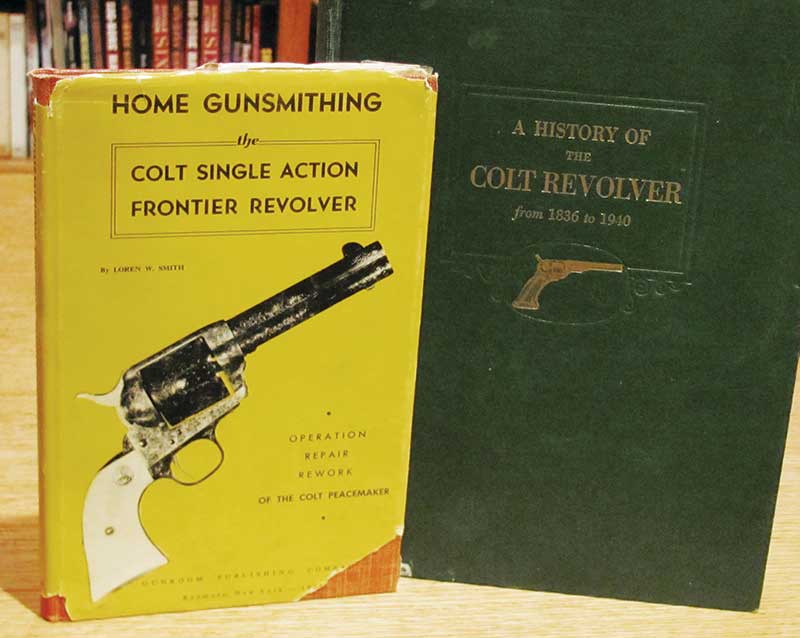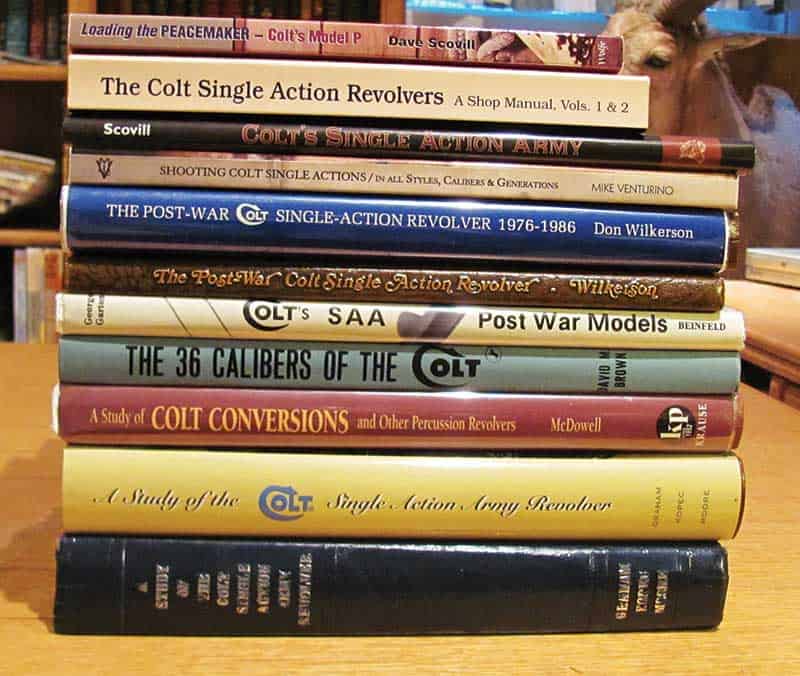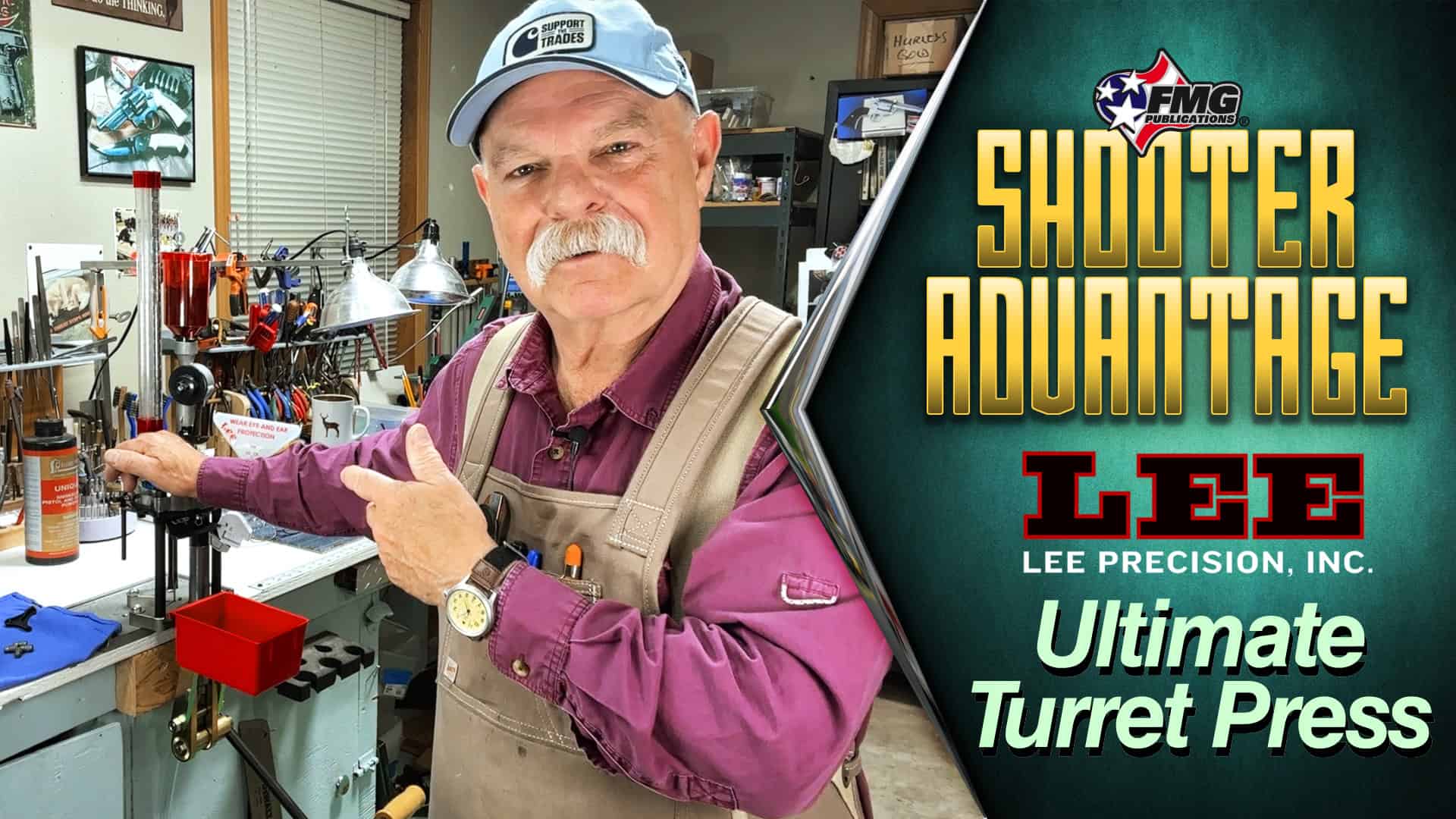Gun Books Part I: Colt Single Actions
Reading up on “the classics” is nearly as much fun as shooting ’em
I was fortunate to grow up in a family who––although would be classified as “poor” today––always had books and magazines around the house, and reading was tremendously important. Add to this the fact my grade school and high school teachers emphasized reading above every other subject, and it is easy to see why books have been a major part of my life.
The 1950’s were a wonderful time to be growing up for many reasons, not the least of which is the idea of “political correctness” was still a long way off in the future. My high school library not only had gun and hunting books, but also all the monthly “outdoor” magazines. At an early age, I joined the Outdoor Life Book Club, and all the books I purchased in high school are still on my shelves.
Today I belong to several book clubs, including The Theodore Roosevelt Library, Firearms Classics, Frontier Classics, and The Library of American Freedoms––they keep books coming at a regular pace. The first books I acquired go back to 1948. For Christmas that year, my younger cousin gave me a copy of Alexander Dumas’ The Three Musketeers, and earlier that year I found a bound copy of a 1920’s National Geographic containing paintings of all the animals of North America. I was 9 years old when I found it on a shelf in an old bookstore, and I didn’t have the $2 to buy it. So I hid it behind some other books until I could come back with the required amount!
For the next several issues, I’ll be looking at gun books I consider to be required works for all firearms’ reference libraries. I can think of no better place to start than Colts. Before WWI, Colt was already producing the Single Action Army, New Service as well as the 1911 Government Model.
The SAA and the 1911 are still being produced by Colt, and both have had a tremendous influence on firearms’ production today. Both single-action Peacemaker clones and the 1911 are now coming from a long list of companies. For this first installment, I’ll discuss books on the Colt SAA. Due to space limitations, I can, of course, only highlight a few of the many excellent books available today (both new and reprinted) as well as those classics available through used book sources.
Opening Up
The first book I ever bought on the Colt Single Action was purchased for the munificent sum of $5 at the first gun show I attended in 1956. It’s a 1955 edition of Loren W. Smith’s Home Gunsmithing: The Colt Single Action Frontier Revolver. It can still be found in reprinted form and is slightly over 100 pages.
As the title implies, it not only covers standard work on the Colt SAA but also deals with custom touches such as a short action and adjustable sights. It also covers the history of the Colt, along with the serial numbers produced each year from the beginning (1873) to the end of the first production run (1940). I still lust after a custom Colt pictured on the pages of this book––adjustable sights, short action, wide Bisley-style trigger, a ventilated rib running the full-length of the barrel, full engraving and ivory stocks. For the past 60 years, I have thought that someday I would have such a gun built for myself. Someday.
The next Colt book I found was the 1940 edition of A History of The Colt Revolver From 1836 to 1940 by Haven and Belden. This book has also been reprinted. It covers the history of all the Colt revolvers, both single and double action, and the semi-autos as well. The most fascinating part of the book, for me, is to see pages from the Colt Catalogs of 1905, 1909, 1926, 1933––especially 1940. There’s also a large section of Colt patents. I found this book in the campus bookstore at Kent State University when I went to purchase my first textbooks in 1960. I doubt that you will find this book––or any such book––in university bookstores today.
The most exhaustive study of the original Colt SAA is A Study Of The Colt Single Action Army Revolver by Graham, Kopec and Moore. This huge volume was first published in 1976 and was followed up by a 30th anniversary edition in 2006, which contains added material. Although there’s really no such thing as the “complete book” of anything, these two volumes come very close to the ideal, as they contain everything about the 1st Generation Colt Single Action Army.
The books are divided into three parts: Civilian, Cavalry and Service Revolvers. The first section is the most interesting to me, with 17 chapters covering everything from the original production to the final sixguns produced in the 357,000 serial number range. In between are Buntline Specials, Rimfire Models, Sheriffs’s Models, Flat-Top Target Models and Bisley Models. Both volumes are prolifically illustrated with standard and engraved versions. It’s very easy get lost for hours in the pages of either edition.
Another favorite of mine is David Brown’s The 36 Calibers of the Colt Single Action Army (1965). Not all collectors agree with the “36” number, however, Brown gives a history of each caliber and provides a full-page illustration of each cartridge. He also has many line drawings showing variations on different Colts as well as reprints of letters from the Colt factory. I find several of his listings to be exceptionally interesting, including the total number of each caliber produced in Flat-Top or Bisley configurations. Of special interest to me is the list of the single actions in .38 Special, .45 Colt and .357 Magnum, which were sold to the British Purchasing Commission in June 1940 for the Battle Of Britain.
Colt resumed production of the SAA in late 1955 with what is now known as the 2nd Generation. In 1976, the 3rd Generation appeared––both are covered in George Garton’s Colt’s SAA Post War Models (1979), Don Wilkerson’s The Post-War Single-Action Revolver (1978), and The Post-War Colt Single-Action Revolver 1976-1986 (1986), also by Wilkerson. These books cover both the SAA and New Frontier Models, complete with serial number ranges, total production by caliber and dates of production for the various calibers as well as the numbers produced––by caliber––in each barrel length.
GUNS’ contributor Mike Venturino has produced four books covering frontier firearms, and one of these is Shooting Colt Single Actions In All Styles, Calibers, and Generations (1995). It’s available in paperback or hardback. In it, Mike covers the Peacemaker’s history as well as how-to information on sighting in, customizing and adding auxiliary cylinders. He also provides information for reloading each of the most prominent calibers of 1st Generation guns with both smokeless and black powder (and the percussion and cartridge conversion guns).
Dave Scovill, former editor of Handloader magazine is an unabashed lover of the Colt SAA. His two books are Loading The Peacemaker: Colt’s Model P (1996) and Colt’s Single Action Army: Loading and Shooting The Peacemaker (2013). The former is a paperback book while the latter is a larger hardback (basically a continuation of the first effort). Dave spends time covering cast bullets with lengthy loading data on the .45 Colt, .44 Special, .44-40, .38-40, .38 Special and .32-20. This book is a valuable asset for anyone who actually shoots his Colts.
A slightly different type of book is The Colt Single Action Revolvers: A Shop Manual, Volumes 1 & 2 (2001) by Jerry Kuhnhausen. His book filled with drawings of virtually everything about the SAA’s operation, tuning, gunsmithing and cartridges. Every part ever used in the production of the Colt is shown in its different variations over the more than 140 years of production. Although I don’t even come close to being a gunsmith (well, I can take an SAA apart and get it back together), I do find the explanation of how things work fascinating.
Before the Colt Single Action Army, of course, there were the Colt Conversions––percussion revolvers converted to fixed ammunition. A Study of Colt Conversions and Other Percussion Revolvers (1997) by R. Bruce McDowell covers this short but important period of sixgun history. Firearms were relatively expensive on the frontier, and everyone just didn’t discard their percussion guns with the coming of fixed-ammunition models.
Dennis Adler is known for beautifully photographed books, and his Colt Single Action From Patersons to Peacemakers (2006) continues the tradition. This is another book you can find yourself immersed in for hours, just studying the pictures of both standard and engraved guns from the Paterson of 1836 through the Walker, Navy and Army Models and Single Action Army.
There are many other books about the Colt Single Action Army, but these are a good starting point.




